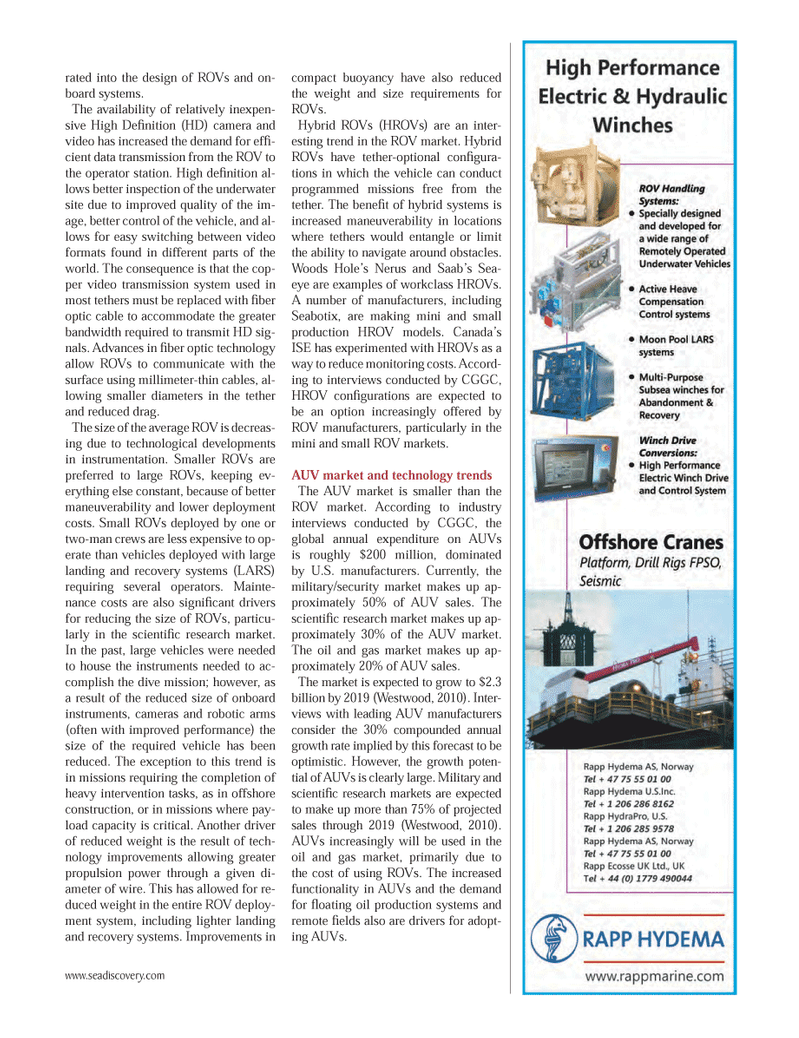
Page 49: of Marine Technology Magazine (September 2012)
Subsea Defense: Protecting Port & Subsea
Read this page in Pdf, Flash or Html5 edition of September 2012 Marine Technology Magazine
rated into the design of ROVs and on- board systems. The availability of relatively inexpen- sive High DeÞ nition (HD) camera and video has increased the demand for efÞ -cient data transmission from the ROV to the operator station. High deÞ nition al- lows better inspection of the underwater site due to improved quality of the im- age, better control of the vehicle, and al- lows for easy switching between video formats found in different parts of the world. The consequence is that the cop- per video transmission system used in most tethers must be replaced with Þ ber optic cable to accommodate the greater bandwidth required to transmit HD sig-nals. Advances in Þ ber optic technology allow ROVs to communicate with the surface using millimeter-thin cables, al- lowing smaller diameters in the tether and reduced drag.The size of the average ROV is decreas- ing due to technological developments in instrumentation. Smaller ROVs are preferred to large ROVs, keeping ev- erything else constant, because of better maneuverability and lower deployment costs. Small ROVs deployed by one or two-man crews are less expensive to op- erate than vehicles deployed with large landing and recovery systems (LARS) requiring several operators. Mainte- nance costs are also signiÞ cant drivers for reducing the size of ROVs, particu- larly in the scientiÞ c research market. In the past, large vehicles were needed to house the instruments needed to ac-complish the dive mission; however, as a result of the reduced size of onboard instruments, cameras and robotic arms (often with improved performance) the size of the required vehicle has been reduced. The exception to this trend is in missions requiring the completion of heavy intervention tasks, as in offshore construction, or in missions where pay-load capacity is critical. Another driver of reduced weight is the result of tech-nology improvements allowing greater propulsion power through a given di- ameter of wire. This has allowed for re- duced weight in the entire ROV deploy- ment system, including lighter landing and recovery systems. Improvements in compact buoyancy have also reduced the weight and size requirements for ROVs. Hybrid ROVs (HROVs) are an inter- esting trend in the ROV market. Hybrid ROVs have tether-optional conÞ gura-tions in which the vehicle can conduct programmed missions free from the tether. The beneÞ t of hybrid systems is increased maneuverability in locations where tethers would entangle or limit the ability to navigate around obstacles. Woods HoleÕs Nerus and SaabÕs Sea- eye are examples of workclass HROVs. A number of manufacturers, including Seabotix, are making mini and small production HROV models. CanadaÕs ISE has experimented with HROVs as a way to reduce monitoring costs. Accord- ing to interviews conducted by CGGC, HROV conÞ gurations are expected to be an option increasingly offered by ROV manufacturers, particularly in the mini and small ROV markets. AUV market and technology trends The AUV market is smaller than the ROV market. According to industry interviews conducted by CGGC, the global annual expenditure on AUVs is roughly $200 million, dominated by U.S. manufacturers. Currently, the military/security market makes up ap- proximately 50% of AUV sales. The scientiÞ c research market makes up ap- proximately 30% of the AUV market. The oil and gas market makes up ap- proximately 20% of AUV sales. The market is expected to grow to $2.3 billion by 2019 (Westwood, 2010). Inter- views with leading AUV manufacturers consider the 30% compounded annual growth rate implied by this forecast to be optimistic. However, the growth poten- tial of AUVs is clearly large. Military and scientiÞ c research markets are expected to make up more than 75% of projected sales through 2019 (Westwood, 2010). AUVs increasingly will be used in the oil and gas market, primarily due to the cost of using ROVs. The increased functionality in AUVs and the demand for ß oating oil production systems and remote Þ elds also are drivers for adopt- ing AUVs. www.seadiscovery.com MTR #7 (34-49).indd 49MTR #7 (34-49).indd 499/10/2012 10:01:48 AM9/10/2012 10:01:48 AM

 48
48

 50
50
